Inherited minerals. The vast majority of minerals found in the coarse sand fraction are inherited from the original material. That is why there is a clear dependence between the mineralogy of coarse sands and the type of parent rock of the soil.
In order to understand soil genesis it is important
to delimit which minerals are inherited from the parent rock and
which minerals have an edaphic origin. It is also interesting
to discover the degree of alteration of the minerals, as well
as the nature of the alteration they show.
![]() Origin
of minerals
Origin
of minerals
Inherited minerals.
The vast majority of minerals found in the coarse sand fraction
are inherited from the original material. That is why there is
a clear dependence between the mineralogy of coarse sands and
the type of parent rock of the soil.
Inherited minerals are: quartz, chert, orthoclase, microcline,
plagioclases, muscovite, biotite, dolomite, siderite, garnets,
disthene, andalusite, staurolite, tourmaline, chloritoids, rutile,
pyroxenes, amphiboles, zoisite, clinozoisite, casiterite, ilmenite
and pyrite.
Soil minerals. The following have been found as minerals
formed by edaphic processes: haematite, goethite, maghemite, calcite,
gypsum, basanite, chalcedony, chlorite, compounds of manganese
and leucoxene.
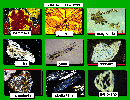
Many of these minerals can also sometimes have an inherited origin, such as the case, for example, of carbonates. Carbonates represent a very mobile component that suffers secondary dissolutions and accumulations, and it is sometimes easy to distinguish inherited carbonates (above all when they have fossil remains) from soil carbonates (occasionally with convolute shapes and impregnated with iron mineralizations, containing clays and frequently located in the macrovoids in the soil). Chalcedony with a detrital origin or formed by edaphic processes from amorphous silica have also been found. In the latter case, the chalcedony grains show a complex fabric, containing iron compounds and even strongly orientated argillans that are more or less disrupted.
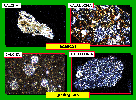
Sometimes the formation conditions of certain minerals are clearly reflected in their distribution in the soil profile. This is the specific case of iron oxides, so abundant in coarse sands of soils developed on limestone rocks, dolomites and marls. Thus haematite and maghemite have very prominent concentrations in the surface horizons of the soils studied (which is in accordance with its conditions of stability), while goethite is concentrated in the deepest, and therefore much more humid, horizons.
|
|
|||
|
Minerals |
|
|
|
|
Increases regularly |
|
|
|
|
Increases irregularly |
|
|
|
|
Remains constant |
|
|
|
|
Varies irregularly |
|
|
|
|
Decreases irregularly |
|
|
|
|
Decreases regularly |
|
|
|
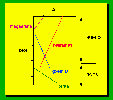
Finally, the frequent presence of some grains formed by a soil fabric matrix aggregate is noticeable, consisting of sands, silt and clay and iron colloids
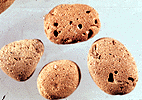
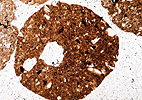
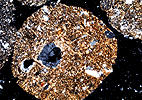
These grains have resisted the normal dispersion treatments and have even remained stable after a continuous mechanical agitation for 96 consecutive hours. They lose their coloration when treated with HCl, due to the elimination of the iron compounds disseminated through the soil groundmass.
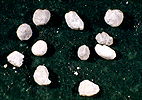
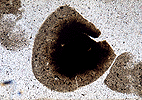
Also noteworthy is that alorthic nodules and concretions have been found (WIEDER and YAALON, 1974). These grains are characterised by having a set of features that reflect the transport these grains have suffered. These features are: differences in the plasmic fabric and/or in the basic fabric, and/or in the mineralogy of skeleton grains with regard to the rest of the soil, very rounded shapes, clear boundaries, concentric fabrics formed by the alternation of different materials, presence of surface "bits" that interrupt the cutan concentric layers over glaebules in elluvial horizons, abundance of grains of quartz sticking out (possibly due to the partial dissolution of the grain during transport). Alorthic grains are especially abundant in the surface horizons of some soils, a fact that appears to indicate that these soils have suffered an important contribution of materials from nearby soils.
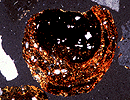
Nature and degree of the alterations
Development and nature of the alterations